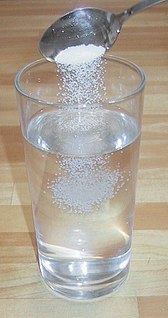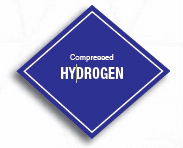
A hydrogen bond is a partially electrostatic force of attraction between a hydrogen (H) atom which is bound to a more electronegative atom or group, such as nitrogen (N), oxygen (O), or fluorine (F)—the hydrogen bond donor—and another adjacent atom bearing a lone pair of electrons—the hydrogen bond acceptor.

In chemistry, a solution is a special type of homogeneous mixture composed of two or more substances. The term aqueous solution is when one of the solvents is water. In such a mixture, a solute is a substance dissolved in another substance, known as a solvent. The mixing process of a solution happens at a scale where the effects of chemical polarity are involved, resulting in interactions that are specific to solvation. The solution assumes the phase of the solvent when the solvent is the larger fraction of the mixture, as is commonly the case. The concentration of a solute in a solution is the mass of that solute expressed as a percentage of the mass of the whole solution.
In thermodynamics, the triple point of a substance is the temperature and pressure at which the three phases of that substance coexist in thermodynamic equilibrium. It is that temperature and pressure at which the sublimation curve, fusion curve and the vaporisation curve meet. For example, the triple point of mercury occurs at a temperature of −38.83440 °C and a pressure of 0.2 mPa.

In metalworking and jewellery making, casting is a process in which a liquid metal is somehow delivered into a mold that contains a hollow shape of the intended shape. The metal is poured into the mold through a hollow channel called a sprue. The metal and mold are then cooled, and the metal part is extracted. Casting is most often used for making complex shapes that would be difficult or uneconomical to make by other methods.

Liquid hydrogen (LH2 or LH2) is the liquid state of the element hydrogen. Hydrogen is found naturally in the molecular H2 form.

Metallic hydrogen is a phase of hydrogen in which it behaves like an electrical conductor. This phase was predicted in 1935 on theoretical grounds by Eugene Wigner and Hillard Bell Huntington.
A propellant or propellent is a chemical substance used in the production of energy or pressurized gas that is subsequently used to create movement of a fluid or to generate propulsion of a vehicle, projectile, or other object. Common propellants are energetic materials and consist of a fuel like gasoline, jet fuel, rocket fuel, and an oxidizer. Propellants are burned or otherwise decomposed to produce the propellant gas. Other propellants are simply liquids that can readily be vaporized.
Supercooling, also known as undercooling, is the process of lowering the temperature of a liquid or a gas below its freezing point without it becoming a solid.

A foundry is a factory that produces metal castings. Metals are cast into shapes by melting them into a liquid, pouring the metal into a mold, and removing the mold material after the metal has solidified as it cools. The most common metals processed are aluminium and cast iron. However, other metals, such as bronze, brass, steel, magnesium, and zinc, are also used to produce castings in foundries. In this process, parts of desired shapes and sizes can be formed.

Gleba is the fleshy spore-bearing inner mass of certain fungi such as the puffball or stinkhorn.
Permanent mold casting is a metal casting process that employs reusable molds, usually made from metal. The most common process uses gravity to fill the mold, however gas pressure or a vacuum are also used. A variation on the typical gravity casting process, called slush casting, produces hollow castings. Common casting metals are aluminium, magnesium, and copper alloys. Other materials include tin, zinc, and lead alloys and iron and steel are also cast in graphite molds.

Plastisol is a suspension of PVC or other polymer particles in a liquid plasticizer; it flows as a liquid and can be poured into a heated mold. When heated to around 177 degrees Celsius, the plastic particles dissolve and the mixture turns into a gel of high viscosity that usually cannot be poured anymore. On cooling below 60 degrees C, a flexible, permanently plasticized solid product results. Aside from molding, plastisol is commonly used as a textile ink for screen-printing and as a coating, particularly in outdoor applications and dip-coating.
Slush hydrogen is a combination of liquid hydrogen and solid hydrogen at the triple point with a lower temperature and a higher density than liquid hydrogen. It is formed by bringing liquid hydrogen down to nearly the melting point that increases density by 16–20% as compared to liquid hydrogen. It is proposed as a rocket fuel in place of liquid hydrogen in order to improve tankage and thus reduce the dry weight of the vehicle.

Compressed hydrogen (CH2, CGH2 or CGH2) is the gaseous state of the element hydrogen kept under pressure. Compressed hydrogen in hydrogen tanks at 350 bar (5,000 psi) and 700 bar (10,000 psi) is used for mobile hydrogen storage in hydrogen vehicles. It is used as a fuel gas.
Solid hydrogen is the solid state of the element hydrogen, achieved by decreasing the temperature below hydrogen's melting point of 14.01 K. It was collected for the first time by James Dewar in 1899 and published with the title "Sur la solidification de l'hydrogène" in the Annales de Chimie et de Physique, 7th series, vol. 18, Oct. 1899. Solid hydrogen has a density of 0.086 g/cm3 making it one of the lowest-density solids.
A casting defect is an undesired irregularity in a metal casting process. Some defects can be tolerated while others can be repaired, otherwise they must be eliminated. They are broken down into five main categories: gas porosity, shrinkage defects, mold material defects, pouring metal defects, and metallurgical defects.
Hydrogen gas porosity is an aluminium casting defect under the form of a porosity or void in an aluminium casting caused by a high level of hydrogen gas (H2) dissolved in the aluminium at liquid phase. Because the solubility of hydrogen in solid aluminium is much smaller than in liquid aluminium, when the aluminium freezes, the dissolved hydrogen gas creates porosity in solid aluminium.
Rocket propellant is a material used either directly by a rocket as the reaction mass, or indirectly to produce the reaction mass in a chemical reaction. The reaction mass is that which is ejected, typically with very high speed, from a rocket engine to produce thrust.












